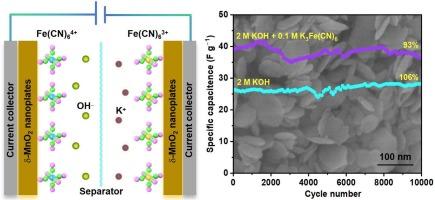Preparation of δ-MnO2 nanoplates for supercapacitors using ultrasonic-assisted liquid-phase co-precipitation technique
IF 4.6
3区 材料科学
Q2 MATERIALS SCIENCE, MULTIDISCIPLINARY
引用次数: 0
Abstract
Birnessite-type manganese dioxide (δ-MnO2) electrode material for supercapacitors (SCs) encounters challenges associated with structural degradation and a reduction in capacitance, rendering the preparation of high-performance δ-MnO2 via simple methods a significant challenge. In this study, a novel and facile ultrasonic-assisted liquid-phase co-precipitation technique has been developed to prepare highly dispersed δ-MnO2 nanoplates with an expanded and disordered interlayer microstructure. The δ-MnO2 nanoplates possess a suitable specific surface area and a wide pore diameter distribution. These structural features facilitate electrolyte ion transport and penetration, thereby enhancing the electrocapacitive properties of the electrode. When fabricated into symmetric SCs, the δ-MnO2 nanoplate-based SCs exhibit excellent cyclic stability, retaining 106 % and 93 % of their initial capacitances after 10,000 cycles at 3 A g−1 in 2 M KOH and 2 M KOH + 0.1 M K3Fe(CN)6, respectively. This work presents a promising approach for preparation of electrode material with superior cyclic stability for SCs.

超声辅助液相共沉淀法制备超级电容器用δ-MnO2纳米片
birnite型二氧化锰(δ-MnO2)超级电容器(SCs)电极材料面临着结构退化和电容降低的挑战,通过简单的方法制备高性能的δ-MnO2是一个重大挑战。在本研究中,我们开发了一种新型的、简便的超声辅助液相共沉淀法,用于制备具有膨胀无序层间结构的高分散δ-MnO2纳米板。δ-MnO2纳米板具有合适的比表面积和较宽的孔径分布。这些结构特征有利于电解质离子的传输和渗透,从而提高了电极的电容性。δ-MnO2纳米板基SCs在2 M KOH和2 M KOH + 0.1 M K3Fe(CN)6中以3 A g−1循环10000次后,表现出优异的循环稳定性,分别保持了106%和93%的初始电容。这项工作为制备具有优越循环稳定性的电极材料提供了一种有前途的方法。
本文章由计算机程序翻译,如有差异,请以英文原文为准。
求助全文
约1分钟内获得全文
求助全文
来源期刊

Materials Science and Engineering: B
工程技术-材料科学:综合
CiteScore
5.60
自引率
2.80%
发文量
481
审稿时长
3.5 months
期刊介绍:
The journal provides an international medium for the publication of theoretical and experimental studies and reviews related to the electronic, electrochemical, ionic, magnetic, optical, and biosensing properties of solid state materials in bulk, thin film and particulate forms. Papers dealing with synthesis, processing, characterization, structure, physical properties and computational aspects of nano-crystalline, crystalline, amorphous and glassy forms of ceramics, semiconductors, layered insertion compounds, low-dimensional compounds and systems, fast-ion conductors, polymers and dielectrics are viewed as suitable for publication. Articles focused on nano-structured aspects of these advanced solid-state materials will also be considered suitable.
 求助内容:
求助内容: 应助结果提醒方式:
应助结果提醒方式:


